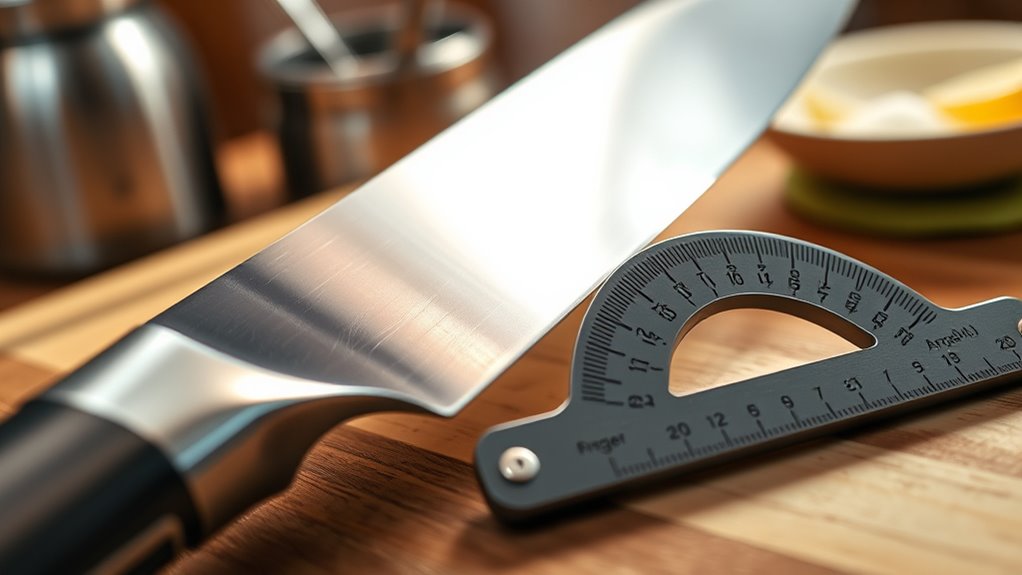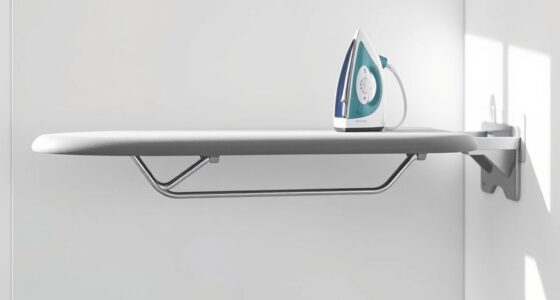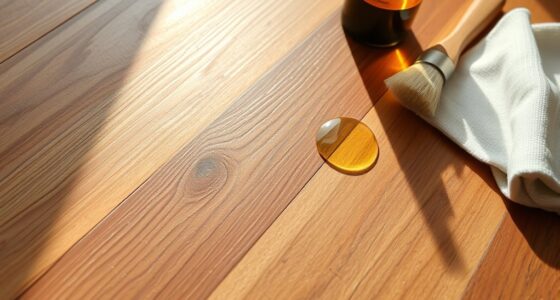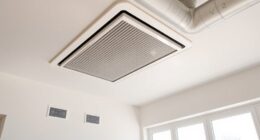To keep your knife sharp, understand its ideal edge angle based on steel type and use. Maintain consistent angles—around 15°–20° for most kitchen knives—using tools like a goniometer or the Sharpie method to check accuracy. Regularly sharpen with the right grit, avoid uneven pressure, and adjust angles slightly for more durability. Special blades like serrated knives need careful, focused sharpening. For more tips on mastering your knife’s edge, discover how proper techniques can make a difference.
Key Takeaways
- Maintain the correct edge angle (15°–20° for most kitchen knives) to balance sharpness and durability.
- Regularly check and adjust the sharpening angle using tools like a goniometer or Sharpie marker.
- Use appropriate sharpening grit and technique to prevent micro damages and keep the edge clean.
- For serrated or specialty blades, sharpen only the grind side with specialized tools to preserve profile.
- Consistently hone and lightly sharpen your knife to remove dullness and maintain optimal cutting performance.
Understanding the Basics of Knife Edge Angles

Understanding the basics of knife edge angles is key to keeping your blades sharp and effective. The edge angle, or sharpening angle, determines how the knife cuts and how durable the edge remains. Most Western‑style knives have a bevel on both sides, typically resulting in a 40° total angle with about 20° per side. If you’re working with Asian knives, you’ll notice either a single bevel or a double-beveled edge. Single bevel knives are sharpened mainly on one side, often at around 20°, while the other side remains flat. Many Asian knives sold in the U.S. are double-beveled but sharpened at approximately 17° per side. Recognizing whether your knife is single or double-beveled helps you set the correct edge angle for ideal sharpening and cutting performance. Additionally, understanding the edge angle can help you determine the optimal balance between sharpness and durability for your specific cutting tasks. Knowing the material of your knife is also important, as different steels respond better to specific sharpening angles and techniques. Properly maintaining your knife’s edge angle can extend its lifespan and improve cutting efficiency, especially as technology advances in AI-assisted sharpening tools. Being aware of the impact of edge angles on performance can help you choose the right angle for different tasks, ensuring your knife remains effective and safe to use. Regularly checking and adjusting your edge angle with proper sharpening techniques can prevent dullness and maintain precision.
How Steel Composition Affects Sharpening Angles
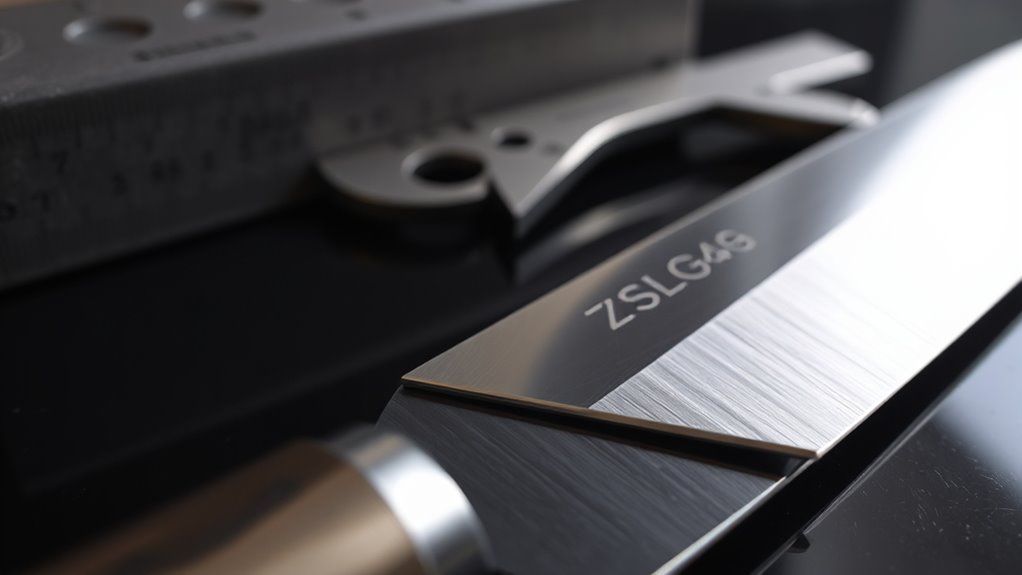
The type of steel in your knife plays a crucial role in determining the best sharpening angle. Steel composition influences both how sharp the edge can be and its edge durability. Harder steels, like high-carbon or super steels, can be sharpened to lower angles—around 15°-17° per side—without sacrificing durability, giving you a sharper, more precise edge. Softer steels, such as certain stainless varieties, require higher sharpening angles—20° or more—to improve edge retention and prevent chipping. Keep in mind, increasing the sharpening angle generally boosts edge durability but may reduce cutting sharpness, especially in softer steels. Understanding your steel’s composition helps you choose the ideal sharpening angles to balance sharpness and longevity.
Optimal Angles for Different Types of Knives
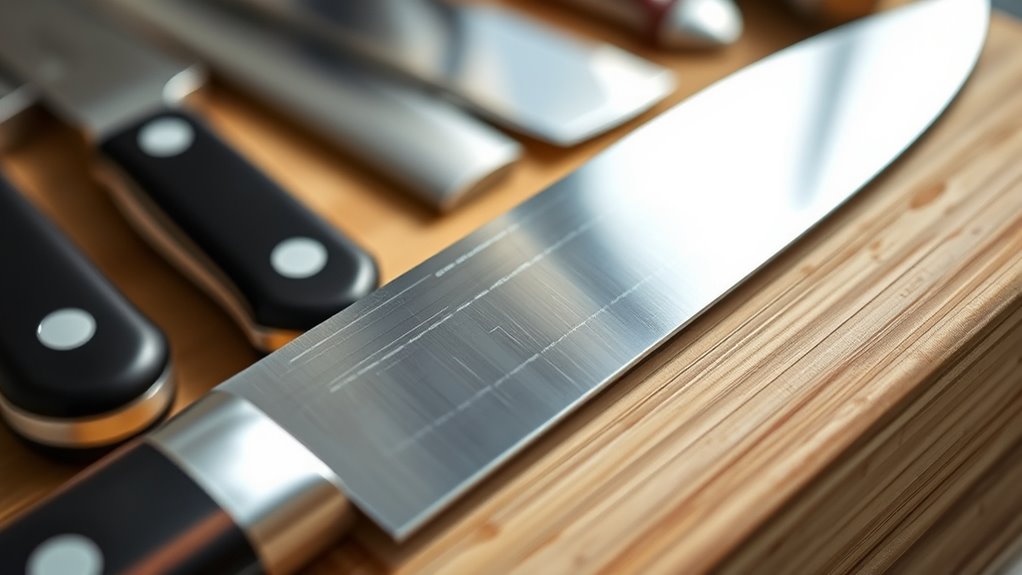
Choosing the right sharpening angle depends on the type of knife you’re working with and how you plan to use it. Different knives require specific angles for peak performance and durability. For example:
- Kitchen knives are typically sharpened between 15° and 20° per side, with 20° offering more durability.
- Japanese knives often feature sharper angles around 15°–17°, thanks to their harder steel.
- Pocket and utility knives usually have angles from 17° to 25°, balancing sharpness and toughness.
- Outdoor and camping blades tend to have wider angles, about 25°–35°, to withstand impact and heavy use.
- Maintaining proper edge angles ensures your knife stays effective and safe, so choose accordingly based on your knife type and intended use.
Techniques for Measuring and Maintaining Proper Angles

To guarantee you maintain the correct edge angle, you can use a goniometer or angle finder to measure it directly on your knife. Alternatively, the Sharpie method lets you mark the bevel and sharpen lightly to see how much of the ink is removed, giving you an estimate of the angle. Regularly checking and adjusting your technique helps preserve the ideal edge for your knife’s best performance. Proper knife maintenance practices also ensure your blade stays sharp longer and performs at its best. Using the correct edge angles is essential for optimal cutting performance and durability. Incorporating professional equipment like honing guides can further improve accuracy during sharpening. Additionally, understanding edge geometry can significantly influence your sharpening success.
Using a Goniometer Tool
Using a goniometer tool allows you to measure and maintain the correct sharpening angle with accuracy. To do this effectively, follow these steps:
- Position the blade so the edge aligns with the goniometer’s adjustable arms.
- Gently stabilize the knife to prevent movement during measurement.
- Read the angle directly from the scale or digital display.
- Compare this angle to your desired sharpening angle and make precise adjustments.
Regularly using a goniometer ensures your blade’s edge maintains a consistent angle, preventing over- or under-sharpening. Keep the tool steady and avoid applying pressure that could damage the blade. With proper technique, you’ll achieve ideal sharpness and prolong your knife’s life by maintaining the correct edge angle.
Sharpie Bevel Marking
Applying a Sharpie to your knife’s bevel is an effective way to visualize and control your sharpening angle. With sharpie bevel marking, you color the entire bevel to see which parts get removed during sharpening. As you use sharpening stones, focus on light strokes and observe the worn ink pattern. If the ink wears evenly across the bevel, you’re maintaining the correct angle on your knife. Uneven ink removal indicates an inconsistent or too-steep angle. Reapplying Sharpie after each adjustment helps you fine-tune your angle, ensuring consistent contact with your sharpening stones. This simple, low-cost method enables you to develop and maintain proper edge angles, especially when honing freehand or with guided systems. It’s an excellent way to improve precision and achieve a sharper, longer-lasting edge.
Adjusting Angles for Enhanced Durability and Performance

Adjusting the sharpening angle can considerably impact your knife’s durability and cutting performance. A slight change in the degrees of the angle of the knife can make a big difference. For example, sharpening at 20 degrees per side enhances edge durability, especially for softer steels. Here are key points to consider:
- Increasing the angle by 1–2 degrees helps prevent rapid dulling and compensates for wear.
- Sharpening at 20 degrees offers a good balance between sharpness and longevity for most knives.
- Lower angles (15–17°) are suitable for harder steels, providing a sharper, more delicate edge.
- Adjusting the angle based on steel type guarantees your knife performs at its best and lasts longer.
- Understanding the importance of edge geometry can help you fine-tune your sharpening technique for optimal results. Additionally, selecting the appropriate filtration technology can extend the lifespan of your sharpening tools by reducing debris and contaminants during the process. Using the right abrasives ensures a cleaner and more precise sharpening experience. Paying attention to proper maintenance of your sharpening tools is essential for consistent results and tool longevity. Incorporating energetic alignment principles can also enhance your overall sharpening effectiveness by promoting a focused and balanced mindset during the process.
Balancing these factors based on your knife’s material and use will optimize performance.
Special Considerations for Serrated and Specialty Blades
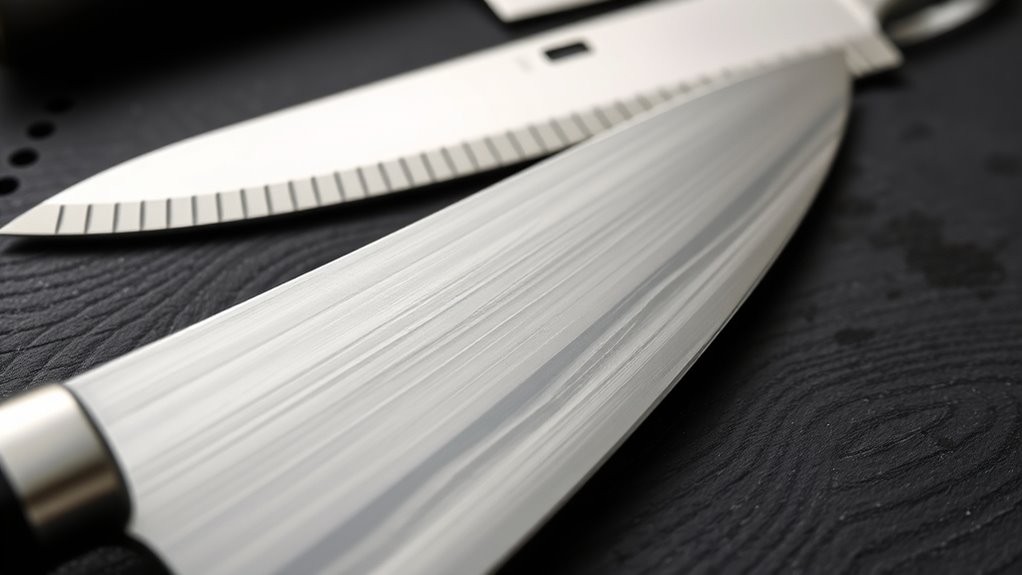
Serrated and specialty blades need careful attention to stay sharp and functional. You should sharpen each tooth carefully, matching the original bevel to avoid damaging the serration profile. Using the right tools, like tapered sharpeners for gut hooks, helps preserve their unique shapes and cutting ability. Incorporate evidence-based techniques to ensure consistent and effective sharpening results. Additionally, understanding the edge angles specific to each blade type is crucial for maintaining optimal performance and longevity.
Sharpening Serration Edges Carefully
When sharpening serrated and specialty blades, it’s essential to use the right tools and techniques to preserve their unique edge geometry. Use a sharpener designed for serrations, such as tapered or cylindrical diamond steels or ceramic sharpeners, to match the original ramp and maintain cutting performance. Focus on these key points:
- Only sharpen the grind side of the serrations to avoid altering the shape.
- Carefully fill the indentation by drawing the sharpener toward the edge.
- Maintain the correct angle to preserve the serration’s effectiveness.
- Use controlled, gentle strokes to prevent over-sharpening or damaging delicate serrations.
- Regular maintenance and understanding of edge angles are crucial for keeping your blades performing at their best, especially when considering the importance of specialized sharpening techniques for different blade types. Paying attention to blade material can also help determine the appropriate sharpening method to extend the lifespan of your knives. Additionally, understanding how blade hardness impacts the sharpening process can help you choose the right approach for different knives.
Restoring Original Ramp Shape
To restore the original ramp shape on serrated and specialty blades, focus on sharpening only the grind side without creating a new bevel. Use a tapered or cylindrical diamond steel or ceramic sharpener to match the original serration profile, filling each serration carefully. Maintain the correct sharpener angle to avoid altering the ramp’s shape. Apply the felt pen trick to mark material removal, performing 5-8 light strokes while rotating the sharpener to ensure even restoration. Be cautious not to over-sharpen, which can distort the serration or remove too much material. Here’s a visual guide:
| Serrated Blades | Restoring Ramp Technique |
|---|---|
| Match sharpener angle | Fill serrations carefully |
| Use light strokes | Maintain original shape |
| Rotate sharpener | Focus on grind side |
| Avoid over-sharpening | Preserve ramp profile |
| Use felt pen trick | Controlled material removal |
Additionally, finding hackathons such as those hosted by MIT or in the USA can provide opportunities to learn new skills and techniques that could be applied to precision sharpening and tool maintenance.
Special Tools for Gut Hooks
Using the right specialized tools is essential for effectively sharpening gut hooks and other specialty blades without damaging their delicate features. A diamond taper or pocket sharpener allows you to precisely sharpen the pointed end of gut hooks while preserving their unique shape. To maintain the integrity of serrations, follow these tips:
- Focus on sharpening only the grind side to prevent distortion.
- Fill the serration indentations with the sharpener for thorough grinding.
- Keep the original ramp angle of serrations to ensure proper cutting.
- Position the sharpener inward at the correct angle, stroking forward and sideways, rotating the tool for consistent contact.
Avoid over-sharpening or applying excess pressure to protect the serration pattern and maintain the blade’s effectiveness.
Common Mistakes and Tips for Effective Sharpening

One common mistake in sharpening is applying inconsistent or excessive pressure, which can create uneven bevels or micro serrations that weaken the edge. To match the existing angle and hone your knife effectively, maintain a steady hand and consistent pressure. Failing to match the original bevel angle often results in poor cutting performance and dullness. Regularly check your progress with a Sharpie to ensure proper angle control. Use the correct grit and technique to avoid burrs or micro damages that diminish sharpness. Here’s a quick guide:
| Mistake | Result | Tip |
|---|---|---|
| Over-sharpening at <10° | Fragile, chipping edge | Match the existing angle precisely |
| Excessive pressure | Uneven bevels | Use light, consistent force |
| Ignoring angle consistency | Reduced cutting power | Use a marker to monitor angle |
| Wrong grit choice | Micro damages, dullness | Pick grit suited for your knife |
| Neglecting regular maintenance | Faster dulling | Sharpen regularly, follow proper technique |
Frequently Asked Questions
How Do You Keep a Consistent Angle When Sharpening a Knife?
You keep a consistent angle by using a sharpening guide or jig set to your desired angle. Keep the knife steady, aligning the edge with the guide or visual marker. Practice the “sharpie trick” to see if you’re maintaining the right angle, and sharpen with even pressure and stroke length. Regularly check your progress and make small adjustments to stay aligned, ensuring a uniform edge every time.
How to Make an Angle Guide for Knife Sharpening?
To make an angle guide for knife sharpening, start by selecting a sturdy piece of scrap wood or plastic. Cut it at your desired bevel angle, like 15° or 20°, using a saw or grinder. Mark the angle precisely with a protractor or angle finder, then secure the guide to your work surface with clamps or tape. This simple homemade guide helps you maintain a consistent edge angle during sharpening.
Why Does My Knife Lose Its Edge so Fast?
You notice your knife dulls quickly because you might be using a softer steel or sharpening at too low an angle, making the edge fragile. Excessive pressure or improper techniques can strip metal, dulling the blade faster. Also, cutting on rough surfaces or neglecting regular honing and proper storage accelerates dulling. To keep your knife sharp longer, use correct sharpening angles, gentle pressure, and maintain it regularly.
What Is the Best Angle for a Knife Edge?
Imagine your knife as a sword in a duel—its edge angle is your armor. For most kitchen tasks, a 20° angle offers a perfect balance of sharpness and strength. If you’re slicing delicate fish, go for 15°–17°. For heavy-duty chopping, wider angles like 22°–30° provide more durability. Match the angle to your needs to keep your knife performing at its best and avoid unnecessary damage.
Conclusion
Think of your knife as a trusted compass, guiding your culinary journey. Keeping the right edge angle is like sharpening its needle, pointing true and steady. With proper care, your blade will slice through your tasks effortlessly, like a whisper in the wind. Remember, a well-maintained edge isn’t just a tool—it’s the compass that leads you to precision and confidence in every cut. Keep it sharp, and let your skills shine through.
